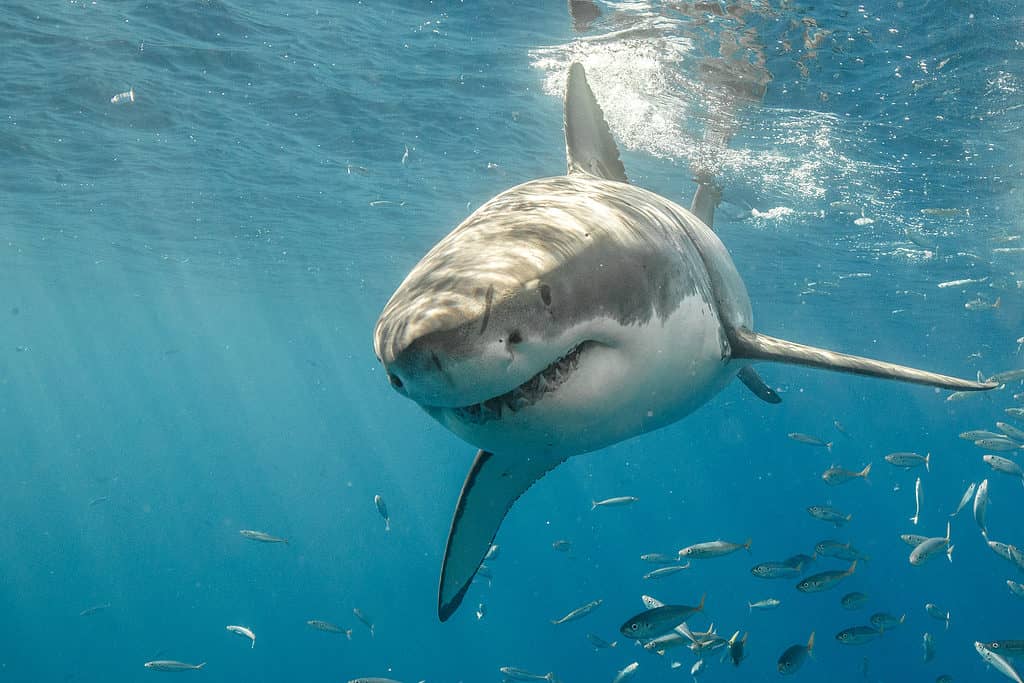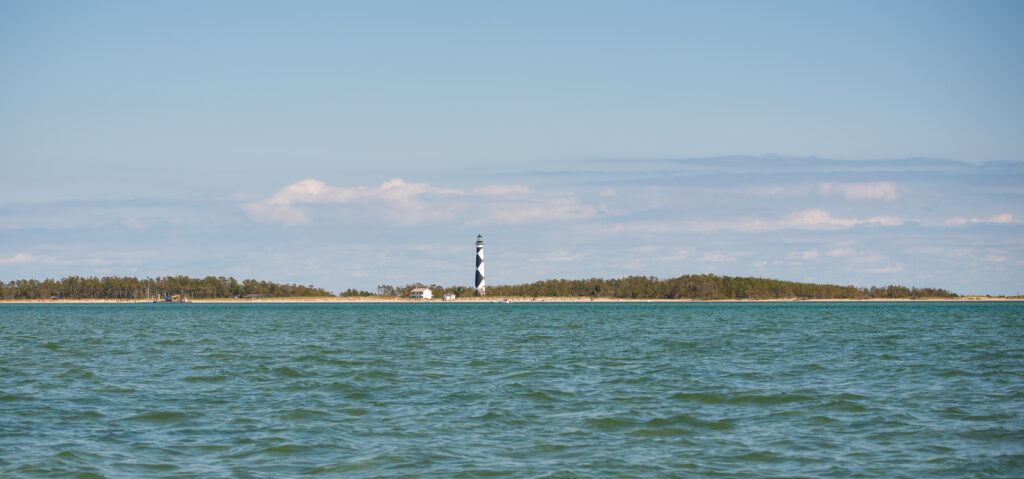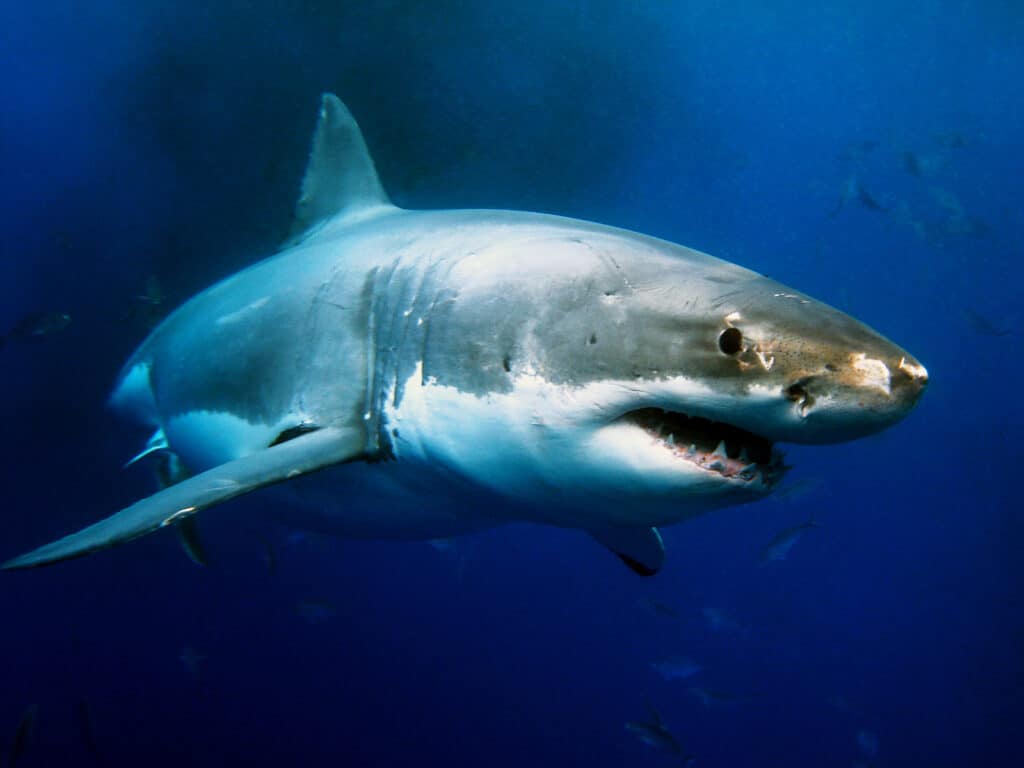There is much about great white sharks (Carcharodon carcharias) that most people do not know, and what they do know is often skewed by Hollywood sensationalism. Jaws frightened an entire generation. And Sharknado… just wow!
OCEARCH seeks to learn more about the ocean’s apex predators and educate the public about the importance of these huge fish. This global non-profit pursues its mission by tagging and tracking great white sharks, most of which are off the Atlantic coast of Canada and the United States.
While OCEARCH tracks the movement of great white sharks from Florida to Nova Scotia, the sharks seem to love the waters of North Carolina, especially in the late winter and early spring. Researchers believe the sharks possibly mate in these waters, which is why they end up in the same area year after year.

Great white sharks are the ocean’s apex predators.
©iStock.com/ShaneMyersPhoto
The Last Piece of the Puzzle
OCEARCH refers to great white shark mating as “the last piece of the puzzle.” Much of the shark’s lifecycle has been tracked, but how and where they mate remains a mystery. Nevertheless, the consistent appearance of the sharks in North Carolina each spring has led researchers to postulate that these waters may be a great white shark nursery.
For a great white shark nursery to be confirmed, three things must be observed.
- There must be evidence that young sharks are found there more often than in other areas.
- These young sharks must remain in the area for an extended period.
- Sharks must use the same area repeatedly for years.
OCEARCH’s tracking data seems to confirm all three points.
If North Carolina is indeed a great white shark nursery, it explains why so many large sharks move into these waters each spring. While OCEARCH tracks many juvenile and sub-adult sharks, it also tracks some massive great whites that have been spotted off the coast of the Tar Heel State.

Are the waters of North Carolina home to a great white shark nursery? It seems likely.
©iStock.com/Penny Britt
Miss Costa
Researchers tagged this female great white shark on September 23, 2016, in Nantucket, Massachusetts. OCEARCH named her in honor of their partner, Costa Sunglasses.
Miss Costa is over 12 feet long and weighs more than 1,000 pounds. Since her 2016 tagging, she has traveled close to 27,000 miles of ocean water. However, the tracking data clearly shows this female shark has an affinity for the waters of Virginia and North and South Carolina. The shark’s highest concentration of pings is consistently found in this area.
OCEARCH places a transmitter on every shark that is tagged. That transmitter allows OCEARCH to monitor the shark’s movement and behavior. When a shark surfaces, a ping is sent that helps researchers geolocate the shark.
Because Miss Costa has been tracked for several years now, clear patterns have been observed. She has ventured as far north as Nantucket Sound in Massachusetts and as far south as Cuba. This great white has also occasionally ventured into the Gulf of Mexico and has been spotted off the coast of the Florida Panhandle. But one pattern has been clearly observed year after year: Miss Costa always returns to the waters of North Carolina.

OCEARCH places transmitters near the dorsal fin of great white sharks to monitor their movement.
©Alessandro De Maddalena/Shutterstock.com
Ironbound
Ironbound is a male great white shark tagged by OCEARCH researchers on October 3, 2019, in Lunenburg, Nova Scotia. The shark was named after West Ironbound Island near Lunenburg.
Ironbound is over 12 feet long and weighs around 1,200 pounds. This shark has been tracked further north than Miss Costa. OCEARCH researchers have located him as far north as Cape Breton Island in Nova Scotia, but only in the summer when the northern waters are warm.
In the spring, this large male great white is known to frequent the waters off the North Carolina coast.

Large great white sharks congregate off the North Carolina coast each year, possibly for breeding.
©Alexius Sutandio/Shutterstock.com
Breton
Ironbound isn’t the largest great white shark observed in North Carolina waters, though. OCEARCH is currently tracking an even bigger shark.
Like Ironbound, Breton was also tagged in Nova Scotia. OCEARCH scientists named the shark in honor of the people of Cape Breton, where it was tagged.
Breton is a male great white that measures over 13 feet long and weighs around 1,500 pounds. This massive male shark is spotted in North Carolina waters even more often than Ironbound, especially in the early spring.
Breton has been tracked in the open ocean, patrolling the deep waters of the North American Basin. However, that data was collected during the late fall and winter months. When spring arrives, Breton consistently moves back to North Carolina.

Great white sharks keep coming back to North Carolina.
©Vincent Legrand/Shutterstock.com
Bigger Sharks?
Are there sharks even bigger than Breton in North Carolina waters? It seems likely, but great white sharks are elusive and difficult to study. This is why OCEARCH is doing such vital work. We have learned much about the life of the great white shark through their research, and we are certain to learn much more in the future.
Summary of the Largest Great White Sharks Ever Found off North Carolina Waters
| Rank | Great White Shark | Size |
|---|---|---|
| 1 | Miss | over 12 feet long and weighs more than 1,000 pounds |
| 2 | Ironbound | over 12 feet long and weighs around 1,200 pounds |
| 3 | Breton | over 13 feet long and weighs around 1,500 pounds |
The photo featured at the top of this post is © iStock.com/DigtialStorm
Thank you for reading! Have some feedback for us? Contact the AZ Animals editorial team.







